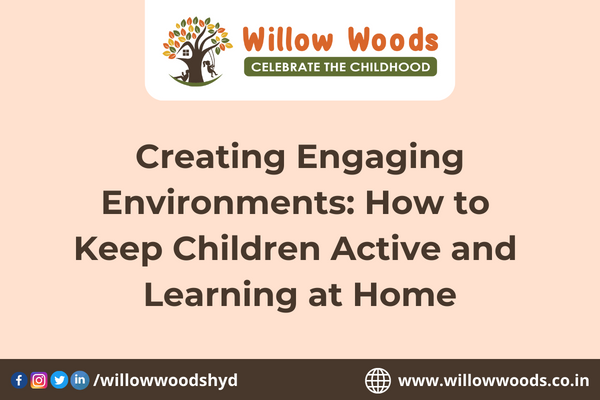IntroductionModeling good behavior is fundamental to nurturing well-rounded children. At Willow Woods Pre School in Mayuri Nagar, we recognize the profound impact of positive role modeling on children’s development. What is Modeling Good Behavior?Modeling good behavior involves demonstrating desirable actions and attitudes that children can emulate. It’s about being a positive influence and showing children
Introduction:
In today’s fast-paced world, where technology dominates many aspects of our lives, it can be a challenge to keep children engaged at home. However, with the right strategies and a little creativity, parents can create stimulating environments that encourage active learning and exploration. At Willow Woods School, we believe in the importance of continuous learning, even outside the classroom. In this article, we will explore practical tips on how to engage children at home, fostering their intellectual growth and keeping their curiosity alive.
Establish a Routine:
Maintaining a structured routine provides a sense of stability for children. Set aside specific times for activities such as reading, playtime, creative projects, and outdoor exploration. A consistent routine helps children understand expectations and creates a sense of order in their daily lives.
Create Learning Spaces:
Designate specific areas within your home for learning activities. Whether it’s a cozy reading nook, an art corner, or a science exploration table, having dedicated spaces for various activities can enhance engagement. Stock these spaces with age-appropriate books, educational toys, art supplies, and hands-on learning materials to make learning enticing and easily accessible.
Encourage Independent Exploration:
Promote independent learning by providing open-ended activities and materials that encourage exploration and problem-solving. Building blocks, puzzles, science kits, and art supplies are fantastic tools for fostering creativity and critical thinking. Encourage your child to ask questions, make predictions, and find solutions on their own.
Incorporate Technology Purposefully:
While excessive screen time can be detrimental, technology can also be a valuable tool for engagement when used purposefully. Explore educational apps, interactive websites, and online learning platforms that align with your child’s interests and learning goals. Monitor screen time and ensure a healthy balance between online and offline activities.
Engage in Family Projects:
Involve the whole family in engaging projects and activities. Whether it’s gardening, cooking, DIY crafts, or building a fort, shared experiences create lasting memories and foster a sense of teamwork. Family projects provide opportunities for children to learn new skills, express their creativity, and develop problem-solving abilities.
Tap into Nature:
Encourage children to connect with nature and explore the outdoors. Nature offers endless learning opportunities, from observing plants and animals to discovering different textures and elements. Take nature walks, set up a mini-garden, or engage in nature-themed crafts to spark curiosity about the world around them.
Foster a Love for Reading:
Reading is a gateway to knowledge and imagination. Create a cozy reading corner with a variety of books, including fiction, non-fiction, and picture books. Set aside regular reading time and engage in storytelling sessions. Visit the library together or explore online resources for e-books and audiobooks. Reading not only enhances vocabulary and language skills but also sparks a love for learning.
Conclusion:
Engaging children at home requires a combination of structure, creativity, and a supportive environment. By establishing routines, creating designated learning spaces, promoting independent exploration, incorporating purposeful technology use, engaging in family projects, tapping into nature, and fostering a love for reading, parents can provide an enriching and stimulating environment that encourages continuous learning and growth. At Willow Woods School, we believe in the power of engaging children both inside and outside the classroom, nurturing their natural curiosity and helping them thrive. Together, let’s create meaningful and enjoyable learning experiences for our children at home.

